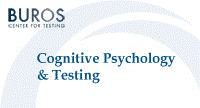Buros-Nebraska Series on Measurement and Testing

The Influence of Cognitive Psychology on Testing
Date of this Version
1987
Document Type
Article
Citation
From The Influence of Cognitive Psychology on Testing, edited by Royce R. Ronning, John A. Glover, Jane C. Conoley, and Joseph C. Witt (Hillsdale, NJ: Lawrence Erlbaum Associates, 1987)
Abstract
The problem of g, essentially , concerns two very fundamental questions: (1) Why are scores on various mental ability tests positively correlated? and (2) Why do people differ in performance on such tests?
SOME DEFINITIONS
To insure that we are talking the same language, we must review a few definitions. Clarity, explicitness, and avoidance of excess meaning or connotative overtones are virtues of a definition. Aside from these properties, a definition per se affords nothing to argue about. It has nothing to do with truth or reality; it is a formality needed for communication.
A mental ability test consists of a number of items. An item is a task on which a person's performance can be objectively scored, that is, classified (e.g., "right" or "wrong," 1 or 0) , or graded on a scale (e.g., "poor," "fair," "good," "excellent," or 0, 1, 2,3), or counted (e.g., number of digits recalled, number of puzzle pieces fitted together within a time limit) , or measured on a ratio scale (e.g. , reaction time to a stimulus or the time interval between the presentation of a task and its completion). Objectively scored means that there is a high degree of agreement between observers or scorers or pointer readings in assigning a score to a person's performance on an item.
An item measures an ability if performance on the item can be objectively scored such that a higher score represents better performance in the sense of being more accurate, more correct, quicker, more efficient, or in closer conformance to some standard-regardless of any value judgment concerning the aesthetic, moral, social, or practical worth of the optimum performance on the particular task . An item measures a mental (or cognitive) ability if very little or none of the individual differences variance in task performance is associated with individual differences in physical capacity, such as sensory acuity or muscular strength, and if differences in item difficulty (percent passing) are uncorrelated with differences in physical capacities per se.
In order for items to show individual differences in a given group of people, the items must vary in difficulty; that is, items without variance (0% or 100% passing) are obviously nonfunctional in a test intended to show individual differences. A test, like any scientific measurement, requires a standard procedure. This includes the condition that the requirements of the tasks composing the test must be understood by the testee through suitable instructions by the tester; and the fundaments of the task (i .e., the elements that it comprises) must already be familiar to the testee. Also, the testee must be motivated to perform the task. These conditions can usually be assured by the testee's demonstrating satisfactory performance on easy exemplaries of the same item types as those in the test proper.
Mental ability tests (henceforth called simply tests) that meet all these conditions can be made up in great variety, involving different sensory and response modalities, different media (e.g., words, numbers, symbols, pictures of familiar things, and objects), different types of task requirements (e.g ., discrimination, generalization, recall, naming, comparison, decision, inference), and a wide range of task complexity. The variety of possible items and even item types seems limited only by the ingenuity of the inventors of test items.


Comments
Copyright © 1987 Lawrence Erlbaum Associates, Inc. Digital Edition Copyright © 2012 Buros Center for Testing.